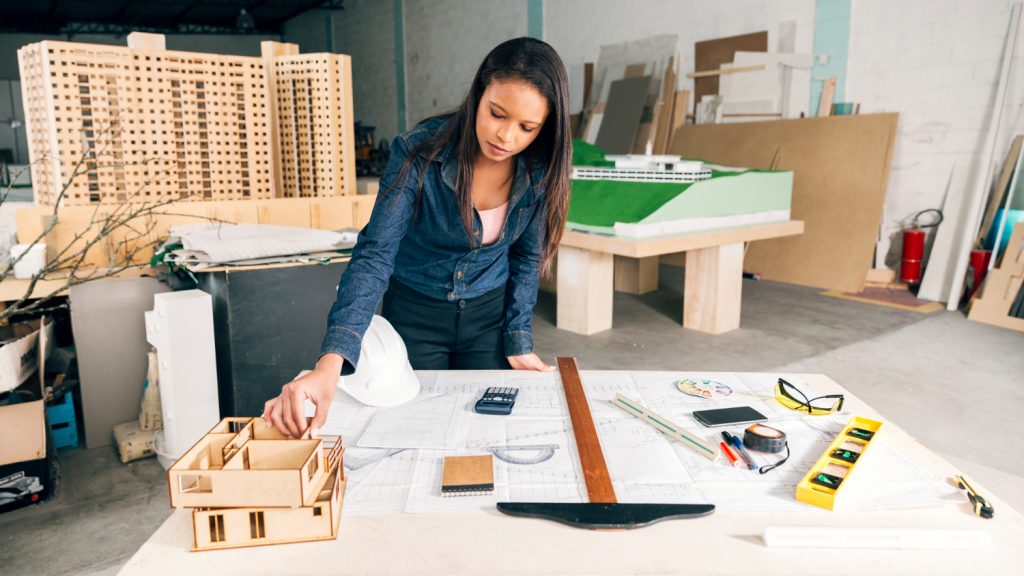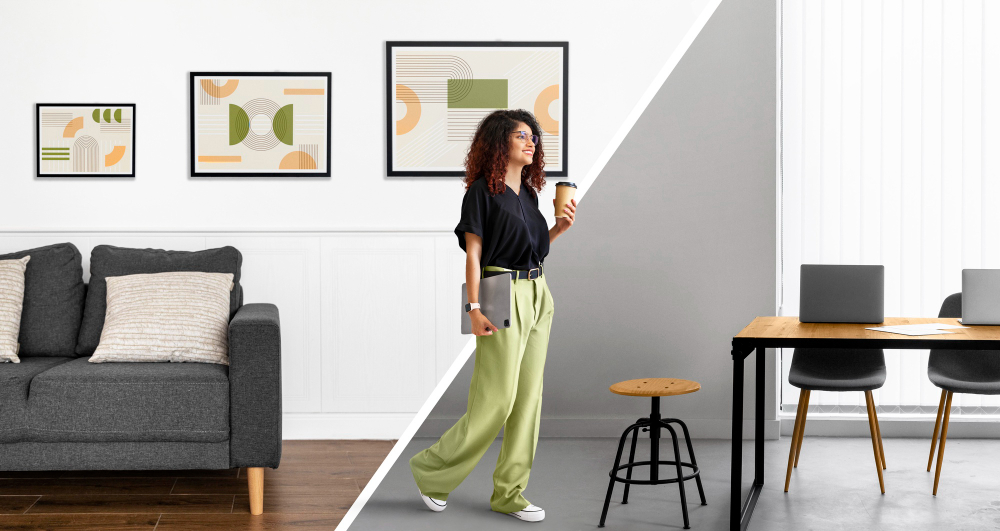Corporate Interior Design | Definition, Steps, Salary
A certified place to work! This certification isn’t just confined to corporate culture but also includes the workspace environment created for employees. The design of commercial spaces plays a pivotal role in reflecting the ethos and culture of a company. Beyond mere aesthetics, corporate interior design serves as a tangible expression of organizational identity, shaping the environment in which employees work and clients engage. With an emphasis on functionality, productivity, and brand representation, this specialized field has become increasingly vital in creating dynamic and engaging workplaces that resonate with stakeholders. This blog helps to uncover the multifaceted significance, the essential skills required to excel, scope, and salary in this particular field.
Definition of Corporate Interior Design
Corporate interior design is the specialized field of designing and enhancing the interior spaces of corporate environments such as offices, workrooms, boardrooms, and commercial establishments. It encompasses the strategic arrangement of furnishings, layouts, and aesthetics to reflect the brand identity, culture, and values of the organization while promoting functionality, productivity, and client engagement.
An example of corporate interior design would be the renovation of a technology company’s headquarters, where the interior designer strategically plans and executes the layout, color schemes, and furniture selection to foster a modern, collaborative workspace that aligns with the company’s innovative ethos and encourages employee creativity and productivity.
Read Also: Interior Design Courses After 12th: Admission, Fee, Eligibility & Salary
Importance of Corporate Interior Design
Do you want free career counseling?
Ignite Your Ambitions- Seize the Opportunity for a Free Career Counseling Session.
- 30+ Years in Education
- 250+ Faculties
- 30K+ Alumni Network
- 10th in World Ranking
- 1000+ Celebrity
- 120+ Countries Students Enrolled
This specialized field within Interior Design focuses on the planning and enhancement of commercial spaces, encompassing offices, retail outlets, and industrial environments. In contemporary settings, Corporate Interior Design is fundamental to the layout and functionality of these spaces, recognizing its pivotal role in facilitating optimal experiences for customers, employees, and visitors alike.
1. Brand Representation:
Corporate interior design plays a crucial role in conveying the essence of a company’s brand and culture. Through careful selection of colors, materials, and layout, the design captures the values and identity of the organization, creating a space that resonates with employees, clients, and visitors alike. Whether it’s a tech startup embracing a modern and vibrant aesthetic or a law firm opting for a more traditional and sophisticated ambiance, the design sets the tone for how the company is perceived.
Book Now →
2. Workspace Personality:
Beyond serving as a functional workspace, the interior design of an office is a reflection of its unique personality. From open-plan layouts that encourage collaboration to private offices that prioritize focus and concentration, every aspect of the design contributes to shaping the office’s character. Whether it’s through quirky decor elements, innovative furniture choices, or branded accents, the design communicates the company’s ethos and values, creating an environment that fosters a sense of belonging and identity among employees.
3. Improves Morale and Productivity:
Do you want free career counseling?
Ignite Your Ambitions- Seize the Opportunity for a Free Career Counseling Session.The design of a workspace has a direct impact on employee morale and productivity. A thoughtfully designed environment that prioritizes comfort, functionality, and well-being can enhance job satisfaction, reduce stress, and boost overall productivity levels. Whether it’s through ergonomic furniture, natural lighting, or flexible workspaces that cater to different work styles, the design supports employee needs and preferences, creating a safe and productive atmosphere for creativity, collaboration, and innovation.
4. Future Growth:
Corporate interior design is not just about the present but also about preparing for the future. A well-designed space takes into account the company’s growth trajectory and evolving needs, allowing for scalability and adaptability. Whether it’s through modular furniture arrangements, flexible layouts, or strategic space planning, the design ensures that the space can easily accommodate expansion and changes in organizational structure, minimizing disruptions and maximizing efficiency.
5. Lighting and Space Optimization:
Lighting helps in creating a comfortable and productive work environment. A well-lit space not only enhances visibility and reduces eye strain but also affects mood, energy levels, and productivity. Corporate interior design focuses on optimizing natural and artificial lighting to create a balanced and pleasant atmosphere that supports various tasks and activities. Similarly, efficient space planning and utilization ensures that every square foot is maximized for functionality and efficiency, whether it’s through smart storage solutions, ergonomic workstations, or multipurpose areas that serve multiple functions.
6. Leisure Spaces:
In addition to work areas, corporate interior design also recognizes the importance of leisure and relaxation in promoting employee well-being and creativity as employees spend more than 50% of their time at their office. Whether it’s a designated break room, a cozy lounge area, or an outdoor terrace, leisure spaces provide employees with opportunities to unwind, socialize, and recharge during the workday. By incorporating elements of comfort, recreation, and personalization, these spaces contribute to a positive and inclusive work culture, fostering camaraderie, collaboration, and overall satisfaction among employees.
Read Also: Top 10 Most Important Skills for Interior Designers

Essential Skills for Corporate Interior Designers
Below are the following skill sets essential for aspiring Corporate Interior Designers:
1. Flexibility and Adaptability:
Corporate Interior Designers must be adaptable to changing project requirements, client preferences, and industry trends. They need to be able to adjust and adapt quickly and effectively to meet evolving needs and ensure project success.
2. Organizational and Time Management Skills:
The ability to organize tasks, manage deadlines, and prioritize work efficiently is essential for handling multiple projects simultaneously and delivering results on time and within budget.
3. Understanding of Sustainable and Eco-Friendly Designing:
In today’s environmentally conscious world, knowledge of sustainable design practices and eco-friendly materials is crucial. Corporate Interior Designers should strive to incorporate green building principles to create healthier, more energy-efficient spaces that minimize environmental impact.
4. Attention to Detail:
Attention to detail is imperative in corporate interior design, as even minor oversights can impact the functionality and aesthetics of a space. Designers must consciously plan every aspect of the project, from furniture placement to lighting design, to ensure a cohesive and polished result.
5. Knowledge of Various Tools Used:
Proficiency in design software such as AutoCAD, Revit, SketchUp, and Adobe Creative Suite is essential for creating accurate drawings, 3D models, and visual presentations. Additionally, familiarity with industry-specific tools and technologies enables designers to streamline workflows and enhance productivity.
Read Also: Step-by-Step Guide of Interior Design Courses After 12th
6. Communication Skills:
Effective communication is key to success in corporate interior design, as designers must articulate their ideas, collaborate with clients and stakeholders to understand company ethos and culture, and also to convey complex concepts clearly and concisely. Strong interpersonal skills facilitate productive interactions and foster positive relationships with clients and colleagues.
7. Budget Management:
Corporate Interior Designers must possess strong financial acumen to develop and adhere to project budgets effectively. They must balance design aspirations with cost considerations, source materials and furnishings within budget constraints, and track expenses to ensure projects remain financially viable. Effective budget management is essential for delivering value to clients while maximizing profitability.
Corporate Interior Designer Salary in 2024
The salary for Corporate Interior Designers in India varies depending on factors such as experience, location, and the specific employer. On average, entry-level Corporate Interior Designers may earn around INR 3-5 lakhs per annum, while mid-level professionals with several years of experience can expect salaries ranging from INR 6-10 lakhs per annum. Senior-level Corporate Interior Designers, including those in managerial or leadership roles, may earn upwards of INR 12-20 lakhs per annum or more.
Additionally, salaries may also be influenced by factors such as the size and reputation of the design firm, the complexity of projects undertaken, and individual skill level and expertise.
Scope for Corporate Interior Design
The field of Corporate Interior Design offers promising prospects for professionals in the coming years, with employment opportunities projected to outpace the average industry growth rate. This growth trajectory is fueled by factors such as population expansion and the rising demand for residential and commercial spaces.
Read Also: 10 Important Elements of Contemporary Interior Design
Industry reports, such as those from MordorIntelligence, forecast significant expansion in the Interior Design Services Market. It is anticipated to surge from approximately USD 131.20 billion in 2023 to around USD 168.49 billion by 2028, reflecting a notable compound annual growth rate (CAGR) of 5.13% during the forecast period spanning from 2023 to 2028.
In India, the commercial sector has witnessed remarkable growth, including the development of malls, showrooms, cafes, hotels, and other industries. This burgeoning commercial landscape amplifies the need for skilled interior designers to meet the escalating demand for corporate interior design services.
Conclusion
As the commercial sectors undergo continuous evolution and expansion, there arises a substantial demand for proficient corporate interior designers. These individuals possess a deep comprehension of brand portrayal, functionality, and sustainable design methods, essential for crafting inventive and stimulating workspaces that foster achievement. The realm of corporate interior design presents an expansive and optimistic outlook, brimming with ample prospects for imaginative expression and career progression. Whether it’s assisting a friend’s or family member’s startup or collaborating with renowned businesses, the role of a corporate designer holds the potential to infuse vitality and enjoyment into both employees’ and clients’ experiences within the corporate arena.
Read Also: 5 Tips for Creating a Cozy and Inviting Home


AAFT has been providing the world with limitless creativity and expression since 1993! Through a dynamic and industry-driven curriculum, AAFT provides engaging and captivating articles to persuasive blogs and empowers its readers to explore diverse avenues of creative media education-related content.











